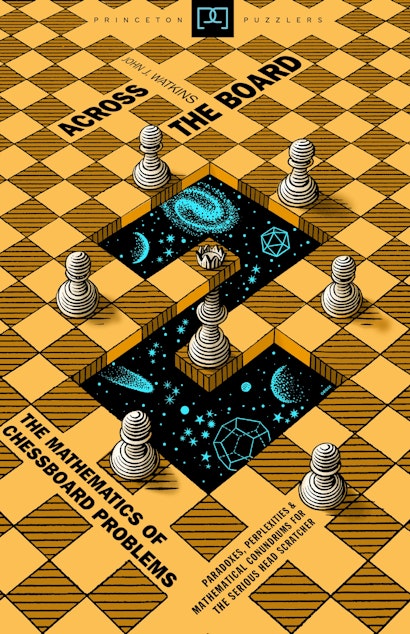Across the Board is the definitive work on chessboard problems. It is not simply about chess but the chessboard itself—that simple grid of squares so common to games around the world. And, more importantly, the fascinating mathematics behind it. From the Knight’s Tour Problem and Queens Domination to their many variations, John Watkins surveys all the well-known problems in this surprisingly fertile area of recreational mathematics. Can a knight follow a path that covers every square once, ending on the starting square? How many queens are needed so that every square is targeted or occupied by one of the queens?
Each main topic is treated in depth from its historical conception through to its status today. Many beautiful solutions have emerged for basic chessboard problems since mathematicians first began working on them in earnest over three centuries ago, but such problems, including those involving polyominoes, have now been extended to three-dimensional chessboards and even chessboards on unusual surfaces such as toruses (the equivalent of playing chess on a doughnut) and cylinders. Using the highly visual language of graph theory, Watkins gently guides the reader to the forefront of current research in mathematics. By solving some of the many exercises sprinkled throughout, the reader can share fully in the excitement of discovery.
Showing that chess puzzles are the starting point for important mathematical ideas that have resonated for centuries, Across the Board will captivate students and instructors, mathematicians, chess enthusiasts, and puzzle devotees.
"This book is extremely well written and is, no doubt, the best exposition of the connection between the chessboard problems and recreational mathematics. The author surveys all the well-known problems about chess and the chessboard. . . . The problems are treated in depth from their beginnings through to their status today."—Mohammed Aassila, MAA Review
"Torus-shaped boards, three-dimensional boards, a shape called the Klein bottle—the simple checkerboard pattern proves to be creatively malleable when Watkins puts his mind to his hobbylike subject. Watkins' invitational tone ensures attention from the finite but enthusiastic audience for mathematical recreation."—Booklist
"Watkins offers an excellent invitation to serious mathematics."—Choice
"I would be happy to recommend this book to you. . . . The book is an easy and entertaining read that shows numerous paths into various branches of discrete mathematics and graph theory."—Paul J. Campbell, Mathematics Magazine
"This is not just about chess, but also the three centuries of 'recreational mathematics' that the game has inspired. From simple questions, such as whether it is possible for a knight to land on each square of the board on its path, Watkins wades into graph theory, the mathematics of three-dimensional chess and even chess on a torus."—Nature Physics
"This book is stimulating and very well written. It is admirably clear. . . . Definitely the book is highly recommended and is of much interest. This book is, no doubt, the newly best exposition of the interconnection between amusing recreational mathematics and the interesting chessboard problems. I feel sure that it will be of great use both to students of graph theory, geometry, topology and mathematics, in general, and captivate to scholars, instructors, chess enthusiasts, puzzle devotees, and to those intervening in amusing and recreational mathematics."—Francisco José Cano Sevilla, European Mathematical Society
"A most enjoyable book that will surely offer new and original avenues for problem solvers of all kinds in need of new techniques, approaches or problems to solve."—Robert Bilinski, Crux
"This beautiful book is absolutely the best treatment of the connection between chess and recreational mathematics I have ever seen. What makes it stand apart (and far above) other chess puzzle books is the underlying mathematical theory, presented in an entertaining, fascinating, and educational manner."—Paul J. Nahin, author of When Least Is Best
"Watkins has a friendly writing style, and the reader is brought along nicely from simple concepts to slightly more complicated ones."—Ron Graham, 2003 Steele Prize for Lifetime Achievement, American Mathematical Society, and President, Mathematical Association of America

